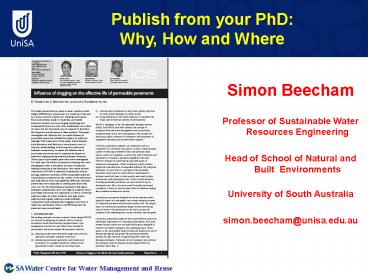WSUD AT OLD CASTLE HILL ROAD SUBDIVISION, CASTLE HILL PowerPoint PPT Presentation
1 / 15
Title: WSUD AT OLD CASTLE HILL ROAD SUBDIVISION, CASTLE HILL
1
Publish from your PhD Why, How and Where
Simon Beecham Professor of Sustainable Water
Resources Engineering Head of School of Natural
and Built Environments University of South
Australia simon.beecham_at_unisa.edu.au
2
Why publish?
- All researchers, to preserve their integrity,
have an obligation to publish the results of
their studies (McMurray et al., 2004) - Nothing is easier than not to publish. Anyone can
be a bad researcher - However, consistent publication requires a high
level of research excellence - Journals and books simply cannot afford to
publish nonsense - Publication is the way to keep researchers on
their toes
McMurray,A., Pace, R. Scott, D.,(2004),
Research a commonsense approach, Victoria,
Thomson Social Science Press. Chapter 1, p. 19-23.
3
Benefits of publishing
- Publication is a pathway to showcasing yourself
and your research and has the capacity to help
you gain personal or commercial competitive
advantage - gain may result in recognition or status in the
form of becoming an authority in a specific
field, and/or - may even be used for promotion
- Research is improved through peer review
- How else could you get two to three highly
intelligent world experts to spend two to three
days of their time analysing your work and
providing constructive feedback?
4
When to Publish
- Once you know enough to have something to say,
then you are ready to publish - Three qualifications of
- authenticity
- originality, and
- significance
5
Where to Publish
- Journal
- Long turn-around time
- often a gap of two to three years between the
completion of a research project and its
publication in a journal - Can be archival
- More prestigious
- Better feedback from reviewers and editor
- Conference
- Immediate feedback
- Publication within 6 or 7 months
- Slacker reviewing
6
Which Journals?
- Publish in high-ranked journals
- Impact factor
- ERA (Australian) ranking (A, A, B or C)
- See http//www.arc.gov.au/era/era_journal_list.ht
m1 - Publish in the field
7
Starting your writing
- Start early, dont underestimate how long it
takes - Have your content set fairly early and start
writing under those headings - Use the questions to structure your writing.
Think of new headings to go with each idea you
feel like writing about. Write under the headings
and rearrange them later if necessary - Dont be perfectionist in the early stage, better
to get started than get it perfect first time - Set a consistent format/template/styles from the
start and use the same software throughout group
8
Some tips
- Understand the writing process
- Managing time and place
- Procrastination is the thief of time
- Understand your audience
- Establish a clear structure
- A picture paints a thousand words
9
Tips Papers in Progress
- Keep a folder on your computer titled Papers in
Progress with sub-folders for each paper on
which you are working - Record your ideas for each paper on a whiteboard
Paper 1 .... .... ....
Paper 2 .... .... ....
Paper 3 .... .... ....
Paper 4 .... .... ....
10
Objectives of a journal or conference paper
- Most people will never read your thesis
- dont think about this too much it can be
depressing - The best way to tell others about your work is
through an international journal or at a
professional conference - This also provides a good opportunity for
feedback - Papers are summaries of your work for
presentation to a broad audience, not all of whom
are experts in your field
11
Purpose of a paper
- Give readers a clear understanding of the
research problem and why it was important - Describe exactly how data were collected
(experimental design and methodology) - Present all data completely and precisely
- Interpret the data and describe how it resolved
the research problem (or not) - To draw conclusions and make recommendations
12
(No Transcript)
13
Research highlights
- The effective porosity was measured and the total
porosity was estimated. - The total porosity shows a good correlation with
the effective porosity. - The exponential equation has been examined for
porous concrete. - A new model using Griffiths fracture theory was
proposed. - Proposed model represents a significant
improvement over the exponential equation.
14
Over to you...
- How many journal papers do you think you can
produce from your research studies? - What are the three main reasons why you are not
publishing right now? - Reason 1.....
- Reason 2 .....
- Reason 3 .....
15
Conclusions
- Publishing in peer-reviewed journals is one of
the best ways of ensuring excellence in your
doctoral or your masters by thesis studies - It brings in anonymous world experts to help you
- If you publish three to four journal papers in
high impact journals, it is a brave external
examiner that questions the findings of these
peer-reviewed processes - It raises your confidence and self-esteem and it
trains you well for a productive future research
career
Simon Beecham Professor of Sustainable Water
Resources Engineering Head of School of Natural
and Built Environments University of South
Australia simon.beecham_at_unisa.edu.au

